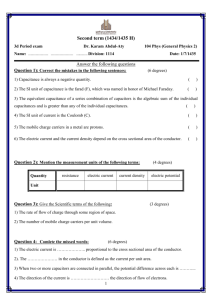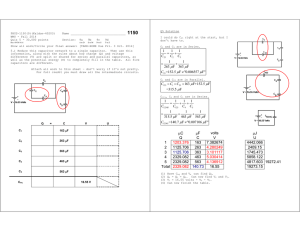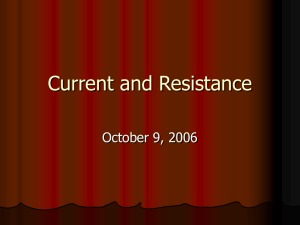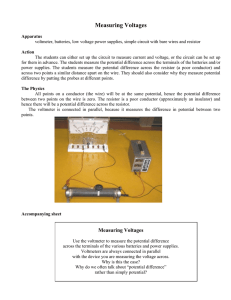Midterm Solutions
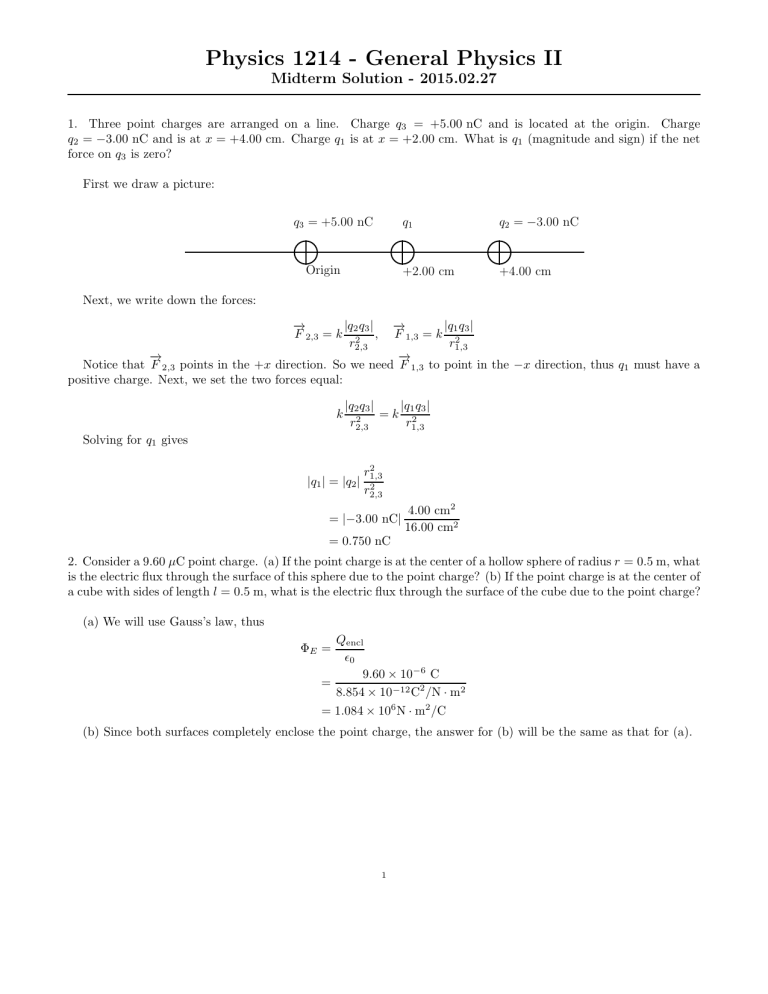
Physics 1214 - General Physics II
Midterm Solution - 2015.02.27
1. Three point charges are arranged on a line. Charge q
3
= +5 .
00 nC and is located at the origin. Charge q
2
= − 3 .
00 nC and is at x = +4 .
00 cm. Charge q
1 is at x = +2 .
00 cm. What is q
1
(magnitude and sign) if the net force on q
3 is zero?
First we draw a picture: q
3
= +5 .
00 nC q
1 q
2
= − 3 .
00 nC
Origin +2.00 cm +4.00 cm
Next, we write down the forces:
2 , 3
= k
| q
2 q
3
| r 2
2 , 3
,
Notice that
−
2 , 3 points in the + x direction. So we need positive charge. Next, we set the two forces equal:
1 , 3
−
1 , 3
= k
| q
1 q
3
| r 2
1 , 3 to point in the − x direction, thus q
1 must have a k
| q
2 q
3
| r 2
2 , 3
= k
| q
1 q
3
| r 2
1 , 3
Solving for q
1 gives
| q
1
| = | q
2
| r 2
1 , 3 r 2
2 , 3
4 .
00 cm 2
= |− 3 .
00 nC |
16 .
00 cm 2
= 0 .
750 nC
2. Consider a 9 .
60 µ C point charge. (a) If the point charge is at the center of a hollow sphere of radius r = 0 .
5 m, what is the electric flux through the surface of this sphere due to the point charge? (b) If the point charge is at the center of a cube with sides of length l = 0 .
5 m, what is the electric flux through the surface of the cube due to the point charge?
(a) We will use Gauss’s law, thus
Φ
E
=
=
Q encl ǫ
0
9 .
60 × 10 −
6 C
8 .
854 × 10 −
12 C
2
/ N · m 2
= 1 .
084 × 10 6 N · m 2 / C
(b) Since both surfaces completely enclose the point charge, the answer for (b) will be the same as that for (a).
1
2
3. A hollow conductor carries a net charge of +13 nC. In its cavity, insulated from the conductor, is a small, isolated object with a net charge of − 5 nC. (a) How much charge is on the outer surface of the hollow conductor? (b) How much is on the wall of the cavity?
We draw a picture of the scenario:
+
+
+
+
+ +
+
-5 nC
+
+
+
+
+
+
Since there is a − 5 nC charge inside the hollow conductor, there must be a +5 nC on the wall of the cavity to balance it out due to Gauss’s law. This is the answer to part (b). As a result, the remainder of the +13 nC charge must remain on the outer surface of the hollow conductor, which is 13 − 5 = +8 nC, which is the answer to part (a).
4. A charge of +28 .
0 nC is placed in a uniform electric field that is directed vertically upward and that has a magnitude of 4 .
00 × 10 4 N / C. What work is done by the electric force when the charge moves (a) 0.450 m to the right; (b) 0.670 m upward; (c) 2.60 m at an angle of 45 .
0 ◦ downward from the horizontal.
First we draw a picture:
− − − − − − − − − − − − −
+28 nC
+
+ + + + + + + + + + + + + +
The force exerted by the electric field on the charged particle points straight upward.
So for part (a), the motion is perpendicular to the force, thus the work done is zero.
For part (b), the force and motion are exactly in the same direction, so we have
W = qEs = (28 .
0 × 10 −
9 C)(4 .
00 × 10 4 N / C)(0 .
760m) = 7 .
50 × 10 −
4 J
For part (c), the component of motion in (or opposite to) the force of the electric field is s = − cos(45 ◦ ) · 2 .
6 m =
1 .
84m. We now have
W = − qEs = − (28 .
0 × 10 −
9 C)(4 .
00 × 10 4 N / C)(1 .
84m) = − 2 .
06 × 10 −
4 J
3
5. In the circuit below, the current flows through the 5 .
0Ω resistor in the direction shown, and the resistor is measured to be consuming power at a rate of 20.0 W. If we assume the batteries have no resistance, what current does the ammeter A read?
15.0 V
A
7.00 Ω
I
5.00 Ω
E =?
2.00 Ω
For the 5 .
00Ω resistor, we use P = I 2 R , solving for I gives I = p P/R = p (20 .
0 W) / (5 .
00 Ω) = 2 .
00 A. If we go around the upper loop counter-clockwise, with current through the 5 .
00Ω resistor labeled as I
1 and current out of the right junction traveling upwards is I
2
, as shown in the figure below.
15.0 V
A
7.00 Ω
I
1
I
2
5.00 Ω
E =?
2.00 Ω
The loop rule, starting at the lower left corner of the loop yields
− I
1
· 5 .
00 Ω + 15 .
0 V − I
2
· 7 .
00 Ω = 0
We know already that I
1
= 2 .
00 A. Solving for the unknown I
2 gives I
2
= 0 .
714 A.
4
6. The circuit below contains two batteries, each with an emf and an internal resistance, and two resistors. Find (a) the current in the circuit (magnitude and direction) and (b) the terminal voltage V ab of the 16.0 V battery.
1 .
6 Ω 16.0 V a b
9 .
0 Ω
5 .
0 Ω
1 .
4 Ω 8.0 V
(a) We have to pick a path around the loop, so let’s pick counter-clockwise. Starting at point b , we have
+16 .
0 V − I · 1 .
6 Ω − I · 5 .
0 Ω − I · 1 .
4 Ω − I · 9 .
0 Ω − 8 .
0 V = 0
Solving for I gives I = 0 .
471 A. Since the calculated current was positive, we have that the current is indeed traveling counter-clockwise.
(b) The potential difference V ab must equal the potential different V ba in magnitude. Thus
V ab
= 16 .
0 V − 1 .
4 Ω · 0 .
471 A = 15 .
2 V
7. An electron is to be accelerated from 3 .
00 × 10 6 the electron pass to accomplish this?
m/s to 8 .
00 × 10 6 m/s. Through what potential difference must
We simply use the conservation of energy: K i in terms of the Electric potential U = qV :
+ U i
K i
+
= qV i
K
= f
+ U f
. But here, we need to rewrite the potential energies
K f
+ qV f
Solving for V i
− V f gives
Now, K = 1
2 m q = 1 .
6 × 10 −
19 e v 2
V i
− V f
, where the mass of the electron m e
C. So
=
K f
− K i q
= 9 .
109 × 10 −
31 kg, and the charge of the electron is
V i
− V f
=
1 m e v
2
= − 156 V
2 f q
− v i
2
5
8. For the system of capacitance shown below, a potential difference of 25 V is maintained across ab . (a) What is the equivalent capacitance of this system between a and b ? (b) How much charge is stored in this system? (c) How much charge does the 6.5 nF capacitor store?
7.5 nF
18.0 nF 30.0 nF 10.0 nF a b
6.5 nF
(a) First we combine the C
1
= 18 .
0 nF, C
2
= 30 .
0 nF, and C
3
= 10 .
0 nF which are in series in the middle of the figure above. In series, we have and solving for C
123 gives C
123
1
C
123
=
1
C
1
+
1
C
2
= 5 .
29 nF. So now we have a C
4
+
1
C
3
,
= 7 .
5 nF, C
123 in parallel. Since these are in parallel, the equivalent capacitance is the sum:
= 5 .
29 nF, and C
5
= 6 .
5 nF capacitor
C
12345
= C
123
+ C
4
+ C
5
= 19 .
3 nF
(b) Now that we have the equivalent capacitance, we can get the total charge by the formula
Q = CV = (19 .
3 nF)(25 V) = 482 nC .
(c) The potential differences across C
4
, C
123 and C
5 are all 25 V. So Q
5
= C
5
V = (6 .
5 nF)(25 V) = 162 nC.

